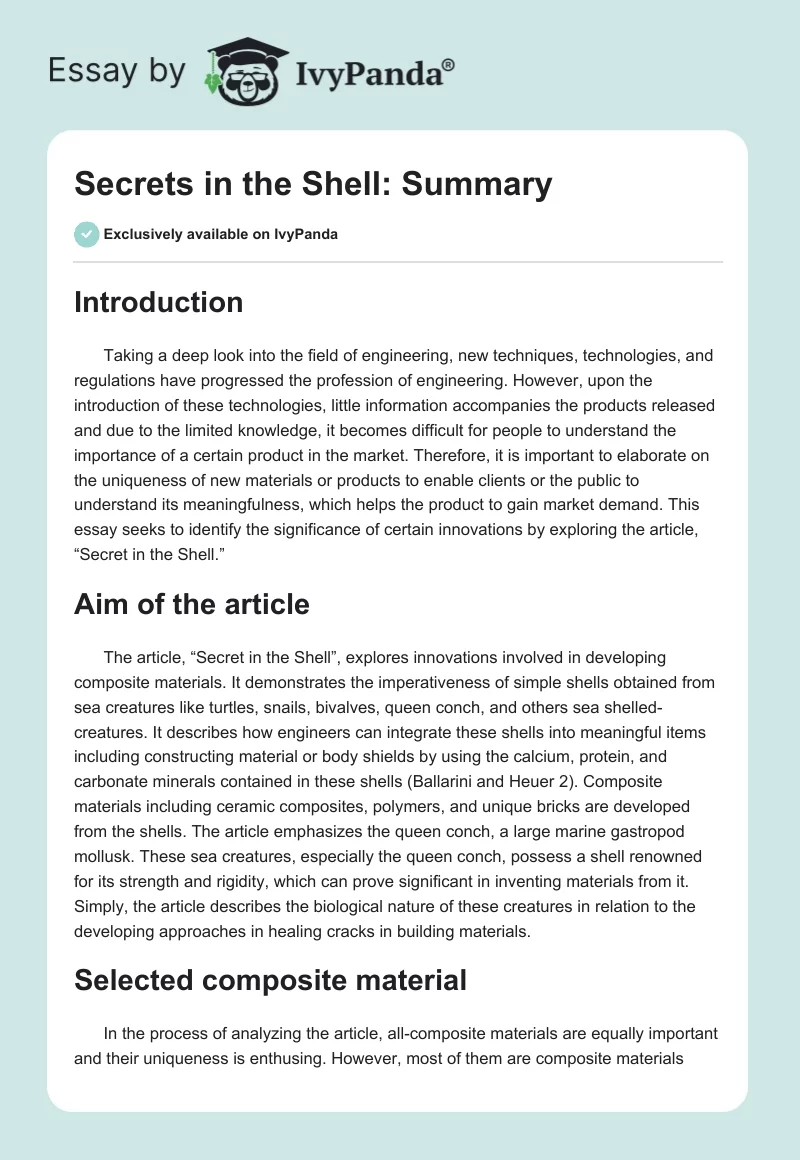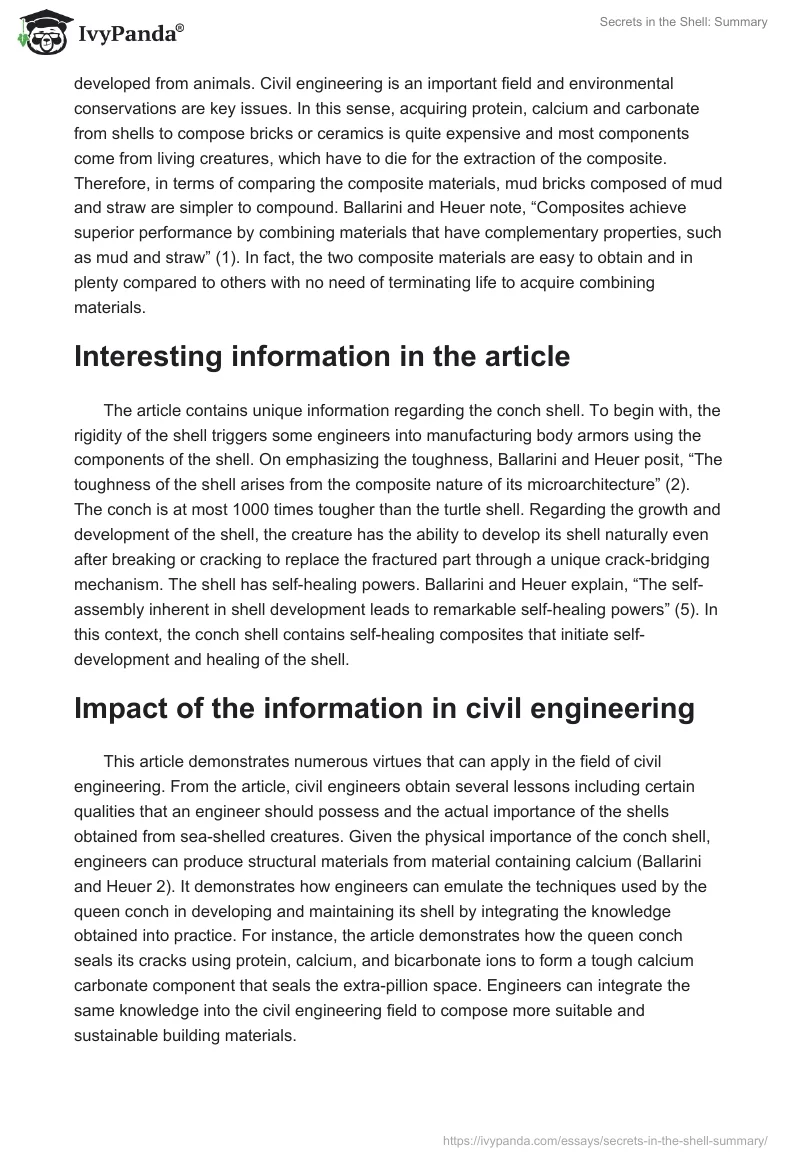Introduction
Taking a deep look into the field of engineering, new techniques, technologies, and regulations have progressed the profession of engineering. However, upon the introduction of these technologies, little information accompanies the products released and due to the limited knowledge, it becomes difficult for people to understand the importance of a certain product in the market. Therefore, it is important to elaborate on the uniqueness of new materials or products to enable clients or the public to understand its meaningfulness, which helps the product to gain market demand. This essay seeks to identify the significance of certain innovations by exploring the article, “Secret in the Shell.”
Aim of the article
The article, “Secret in the Shell”, explores innovations involved in developing composite materials. It demonstrates the imperativeness of simple shells obtained from sea creatures like turtles, snails, bivalves, queen conch, and others sea shelled-creatures. It describes how engineers can integrate these shells into meaningful items including constructing material or body shields by using the calcium, protein, and carbonate minerals contained in these shells (Ballarini and Heuer 2). Composite materials including ceramic composites, polymers, and unique bricks are developed from the shells. The article emphasizes the queen conch, a large marine gastropod mollusk. These sea creatures, especially the queen conch, possess a shell renowned for its strength and rigidity, which can prove significant in inventing materials from it. Simply, the article describes the biological nature of these creatures in relation to the developing approaches in healing cracks in building materials.
Selected composite material
In the process of analyzing the article, all-composite materials are equally important and their uniqueness is enthusing. However, most of them are composite materials developed from animals. Civil engineering is an important field and environmental conservations are key issues. In this sense, acquiring protein, calcium and carbonate from shells to compose bricks or ceramics is quite expensive and most components come from living creatures, which have to die for the extraction of the composite. Therefore, in terms of comparing the composite materials, mud bricks composed of mud and straw are simpler to compound. Ballarini and Heuer note, “Composites achieve superior performance by combining materials that have complementary properties, such as mud and straw” (1). In fact, the two composite materials are easy to obtain and in plenty compared to others with no need of terminating life to acquire combining materials.
Interesting information in the article
The article contains unique information regarding the conch shell. To begin with, the rigidity of the shell triggers some engineers into manufacturing body armors using the components of the shell. On emphasizing the toughness, Ballarini and Heuer posit, “The toughness of the shell arises from the composite nature of its microarchitecture” (2). The conch is at most 1000 times tougher than the turtle shell. Regarding the growth and development of the shell, the creature has the ability to develop its shell naturally even after breaking or cracking to replace the fractured part through a unique crack-bridging mechanism. The shell has self-healing powers. Ballarini and Heuer explain, “The self-assembly inherent in shell development leads to remarkable self-healing powers” (5). In this context, the conch shell contains self-healing composites that initiate self-development and healing of the shell.
Impact of the information in civil engineering
This article demonstrates numerous virtues that can apply in the field of civil engineering. From the article, civil engineers obtain several lessons including certain qualities that an engineer should possess and the actual importance of the shells obtained from sea-shelled creatures. Given the physical importance of the conch shell, engineers can produce structural materials from material containing calcium (Ballarini and Heuer 2). It demonstrates how engineers can emulate the techniques used by the queen conch in developing and maintaining its shell by integrating the knowledge obtained into practice. For instance, the article demonstrates how the queen conch seals its cracks using protein, calcium, and bicarbonate ions to form a tough calcium carbonate component that seals the extra-pillion space. Engineers can integrate the same knowledge into the civil engineering field to compose more suitable and sustainable building materials.
Civil engineering is the field of engineering cornered with several challenging experiences. Engineers encounter devastating experiences such as the formation of cracks on walls of building under construction, or even accidental falling of an entire wall under construction. This article demonstrates the determination of the queen conch towards overcoming challenges regarding the cracking of its shell. Instead of weakening after developing cracks on the shell, it becomes even harder after refilling its crack. Ballarini and Heuer note, “Self-healing material must somehow sense damage, attract healing supplies to the damaged area, and initiate repairs that match the structure of the existing material” (5). Engineers should be motivated by how the queen conch overcomes the cracking of the shell and develops mechanisms to strengthen it even more.
Conclusion
The article contains vital information on innovations that can probably create a unique technique of healing cracks in construction materials. The article demonstrates how engineers can integrate simple shells into meaningful composites by extracting protein and calcium. It demonstrates the natural crack-bridging technique of the queen conch to seal its fractured shell. However, attempting to obtain composite from the shell seems challenging, as civil engineering is a vast field that needs an endless source of resources. In fact, the shelled animals are scarce and combing materials such as calcium and protein endanger them.
References
Ballarini, Roberto, and Arthur Heuer. “Secrets in the shell: the body armor of the queen conch is much tougher than comparable systematic materials. What secrets does it hold?” American Scientist 95.5 (2007): 1-6. Print.


